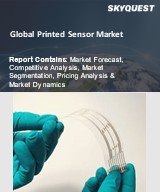
Report ID: SQMIG20D2253
SkyQuest Technology's Printed sensors market size, share and forecast Report is based on the analysis of market data and Industry trends impacting the global Printed Sensors Market and the revenue of top companies operating in it. Market Size Data and Statistics are based on the comprehensive research by our Team of Analysts and Industry experts.
Global Printed Sensors Market size was valued at USD 9.53 million in 2023 and is poised to grow from USD 10.04 million in 2024 to USD 15.3 million by 2032, growing at a CAGR of 5.4% during the forecast period (2025-2032).
The growth of the printed sensor market is seen as tremendous, with a variety of growth factors influencing its direction. The more and more usage of IoT in many industries helps to push printed sensors as they are flexible, cheap, and scalable. Such sensors perform the function of real time data transmission in real time, providing smart applications in these industries including hospital, vehicle and consumer electronics. Advances in printing technologies and materials have extended the functionality and versatility of the sensors, and which have consequently stimulated innovation and market growth. An ever-increasing interest in energy savings and sustainability leads to the mass implementation of printed sensors in the fields like pollution reduction, renewable energy and smart building. Through the deployment of these sensors, higher precision and affordability could be achieved in the monitoring of environmental variables which are relevant for climate change mitigation and the promotion of sustainability strategies.
The printed technology market happens to be a fast growing one for several reasons, and one can't forget the packaging industry that has experienced a rapid increase in demand. These sensors are of utmost importance in improving the labelling which in turn boosts the sales by drawing the customer’s attention towards new product lines and providing additional product info and authentication facilities. Using these devices in different applications including smart appliances attached directly to the power grid can affect the performance as the size of their components is bigger. To make the sharing of data practical, however, such devices must also be based on flexible, lightweight, and thin materials. The fact that printed sensors hold edge over the traditional ones spells a great future for it over a forecast period.
The players in this industry are moving forward by introducing new technologies, forming strategic partnerships and making entries into new markets. Strategic partnerships among sensor producers, electronic firms, and end-users, the principal actors in introducing innovation and market entry, are skilling the market increase.
Yet, a significant drawback affecting this market is the fragility of the sensors. Due to their thin nature, printed sensors are prone to breakage, posing a notable concern. These sensors contain embedded digital information, raising privacy concerns in the event of theft. Moreover, technical complexities surrounding the selection of suitable materials according to specific requirements, coupled with substantial setup investments, are anticipated to impede the growth of the Printed Sensor Market throughout the forecast period. Meeting the requisite performance standards in real-time applications, such as glucose level monitoring and continuous tissue oxygen monitoring, is expected to present a formidable challenge for the printed sensor market in the coming forecast period.
REQUEST FOR SAMPLE
Want to customize this report? This report can be personalized according to your needs. Our analysts and industry experts will work directly with you to understand your requirements and provide you with customized data in a short amount of time. We offer $1000 worth of FREE customization at the time of purchase.
Feedback From Our Clients

Report ID: SQMIG20D2253
sales@skyquestt.com
USA +1 351-333-4748